College is, without a doubt, a life-changing experience. For many, it’s the first time they’re no longer surrounded by their family, and their parents can no longer control them. There is so much to learn, so many things to do, and countless decisions to make.
Amidst all of these newfound freedoms, it becomes very easy to develop an addiction. Statistics say that as many as 37% of students abuse alcohol or illegal substances. That’s why it’s crucial to know how to prevent this grave problem.
From this article by our psychology writing experts, you will learn:
- the main types of addiction in students;
- ways to avoid developing them;
- where to look for help in case things get out of control.
🎓 Why Do Students Develop Addictions?
You may be wondering, what exactly is the mechanism behind addictive behaviors?
Well, the culprit here is dopamine—one of our “feel-good hormones.” It tells your brain that what you’ve been doing is a desirable activity that should be repeated. Addictive substances trigger this hormone’s release, making users want to take the drug again and again.
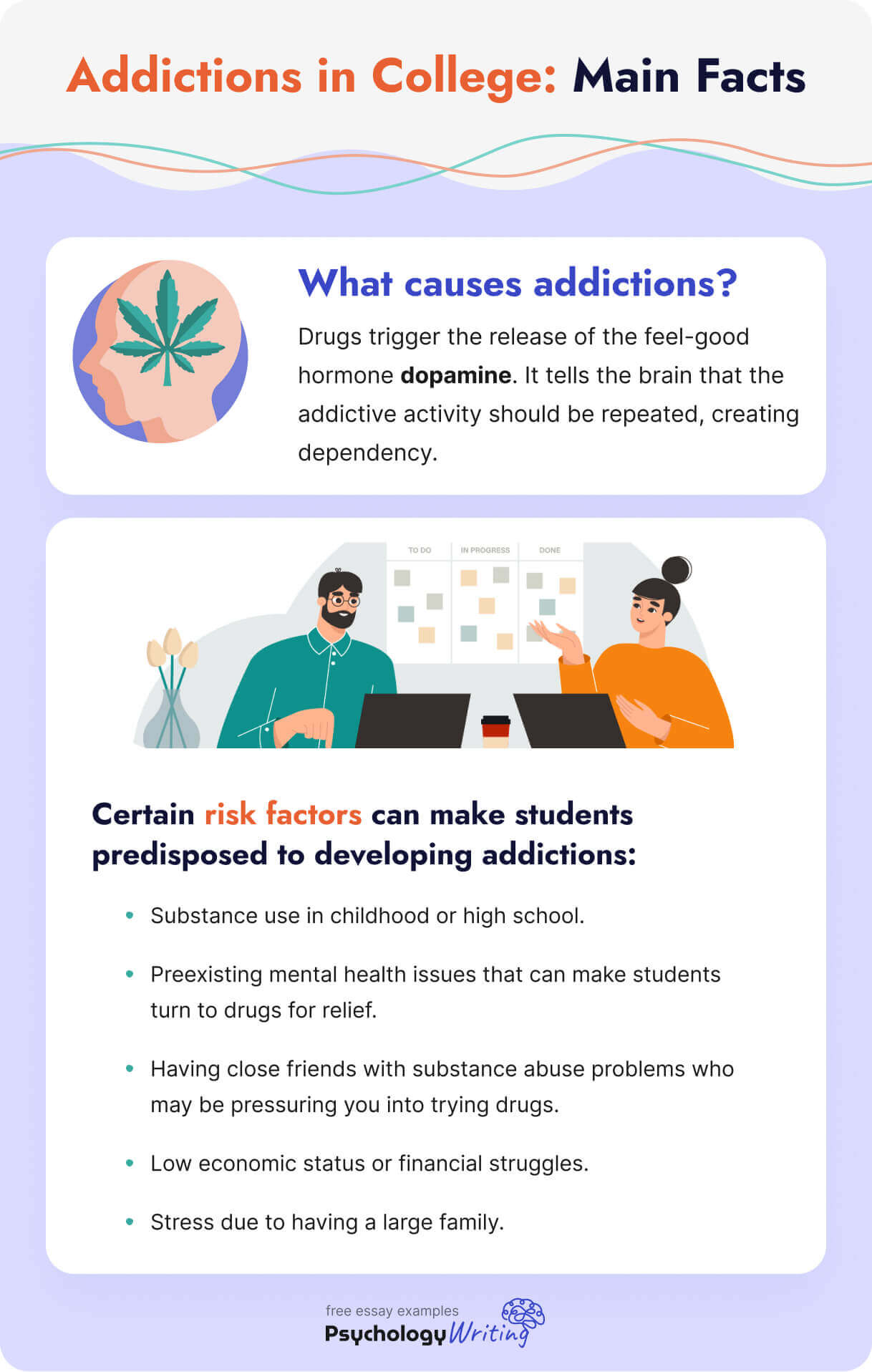
Let’s imagine that today’s the day you fly out of the nest to start college. As exciting as it is, this major life change brings about certain situations that may prompt students to dabble in substances. Let’s have a closer look at them:
☝️ Risk Factors for Developing Addictions in College
If a person is about to go to college, it doesn’t mean they’re bound to develop an addiction. However, we can confidently say that several factors can affect a student’s predisposition to drug abuse..
These red flags include:
- Substance use in high school. Preexisting addiction, even mild, can be aggravated by new stressful circumstances.
- Mental health issues. Often, mental health problems first present themselves during the transition into adulthood. To overcome them, students may turn to alcohol and drugs instead of seeking help from qualified professionals.
- Close friends with addictions. We are all somewhat influenced by the people closest to us. Even if there’s no real pressure to fit in, being exposed to drugs every time we see our friends increases our chances of eventually trying them.
- Low economic status. Alcohol and drugs can be used as a coping mechanism for people who struggle financially. Large family size. Often paired with low economic status, this factor can increase the likelihood of a child turning to drugs as an escape.
🚭 Types of Addictions among Students
Whenever the topic of addiction comes up, we inevitably think of substance abuse first. This type of addiction primarily refers to alcohol, prescription drugs, and nicotine—relatively easily-accessible yet harmful substances. Let’s have a look at their effects and the dangers associated with them.
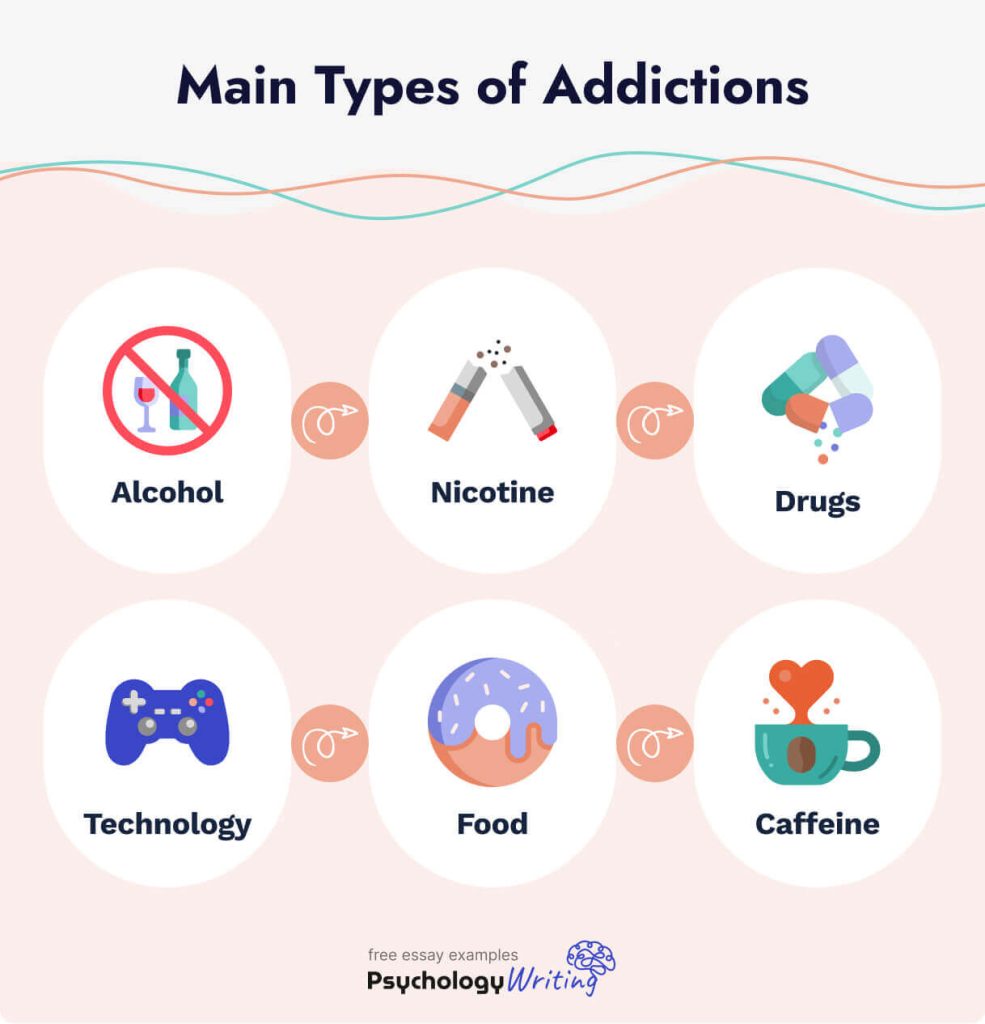
Alcohol Addiction
Alcohol is a socially acceptable substance. For many people, its consumption is an ordinary pastime. This fact can make it difficult to notice an addiction once it develops.
Besides, the prevalence of alcohol makes drinking an easy habit to pick up. Statistically, it is more widespread than drug addictions because it’s so conventional.
What Are the Types?
Why Is It Dangerous?
Aside from being an extremely unhealthy habit, alcohol consumption is the culprit behind many other dangers that can be fatal:
- Academic setbacks. Advanced stages of alcohol dependency will inevitably interfere with a student’s ability to perform well academically, leading to depression and anxiety.
- Assault. Each year, an incredible number of students are assaulted by someone under the influence.
- Sexual assault. The majority of women who experience sexual assault during their college years are attacked by drunken perpetrators.
- Death. Alcohol intoxication leads to drunk driving. According to NIAAA, as many as 1519 students die from alcohol-related injuries, including car crashes.
What Are the Signs?
A few telltale signs indicate a person has developed a severe alcohol addiction. If you notice them, know that it is time to seek help:
- Strong desire to consume alcohol.
- Missing classes and neglecting assignments in favor of drinking.
- Requiring more and more alcohol to experience the same level of intoxication.
- Inability to stop drinking.
- Withdrawal symptoms such as nausea and sweating.
Nicotine Dependence
Another somewhat socially acceptable addiction is nicotine. We’re so used to seeing people smoking that we don’t pay much attention to it.
But the omnipresence of this habit doesn’t take away from its dangers. Nicotine is a highly addictive chemical with a wide range of adverse effects and is extremely difficult to quit.
What Are the Types?
Why Is It Dangerous?
It might be comforting to realize that, unlike alcohol, cigarettes and vapes will not put you in a state of extreme intoxication. However, the harm they cause may still lead to tragic outcomes.
Nicotine is a harmful substance, but other components of cigarettes and vapes magnify the adverse effects. Here’s how smoking can undermine your health:
- Cancer. The risk is not limited to lung, mouth, and throat cancers. You may be surprised, but smoking also increases your chances of getting cervical, bladder, and pancreatic cancers.
- Impaired cognitive function. Research shows that smoking cigarettes and vaping can lower a person’s learning and memorizing abilities.
- Various pulmonary diseases. These include chronic bronchitis, asthma, and emphysema.
- Cardiovascular diseases. Long-term smokers are no strangers to heart attacks and strokes.
- Early death. Statistics show that a smoker’s life expectancy is 10 years shorter than that of a nonsmoker.
What Are the Signs?
Even though nicotine leaves your system relatively quickly, its effects build up, and you develop dependency over time. Let’s see how this addiction manifests:
- Desire to smoke multiple times a day.
- Withdrawal symptoms such as irritability, headache, anger, intense hunger, insomnia, and digestive issues.
Drug Addiction
Now we have moved into the territory of more dangerous substances. Illegal drug use is highly stigmatized, which forces users to conceal their addiction much more than your average alcohol drinker or cigarette smoker. This is especially perilous for college students since, sadly, they are the number one consumers of illegal drugs.
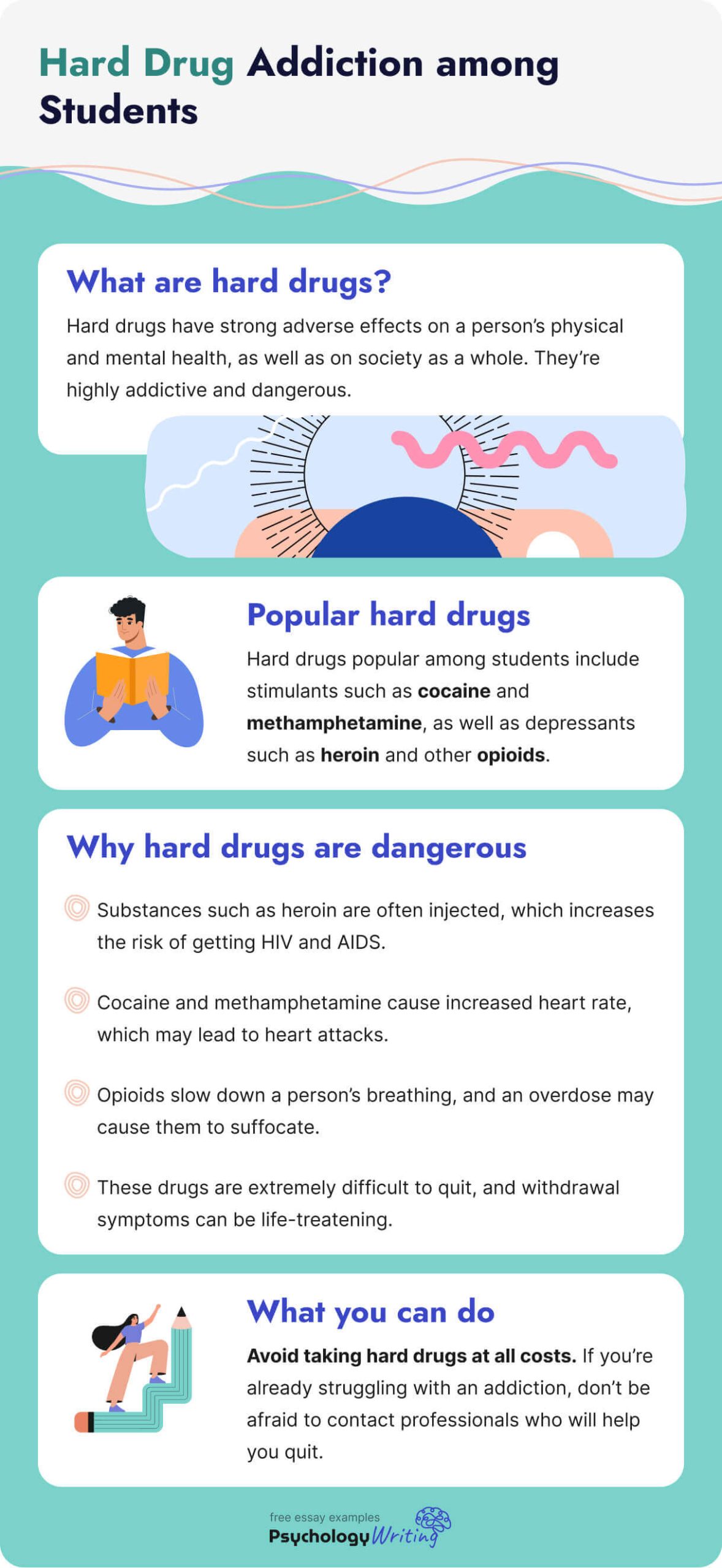
What Are the Types?
Why Is It Dangerous?
We are sure that you are well aware of how dangerous these drugs may be and how difficult it is to stop using them. Still, let’s have a closer look at the threats posed by each group of substances:
- Stimulants.
Stimulating study drugs such as Ritalin or Adderall are popular among students who want to excel in their studies. The problem is that the purpose of these drugs is to treat ADHD and not to improve focus in all students. Taking them when you don’t have an attention disorder makes you more susceptible to developing dependency. Adderall addiction in college students may lead to overdosing and can even be fatal. - Sedatives.
This type of medication is prescribed for treating insomnia and anxiety. Taking large doses of sedatives may also lead to the feeling of euphoria and pain relief.
However, the supposed benefits come at a price. A sedative can mess with your memory and cause you to feel drowsy or out of breath. What’s worse, mixing different sedatives can be fatal. - Hallucinogens.
These come from various sources and have different effects. Some cause visual or auditory hallucinations. Others affect how people perceive time and space, intensifying feelings and experiences.
But not all hallucinations are fun. It’s been reported that this type of drug may cause psychosis and paranoia, memory loss, disorientation, and many more negative consequences. - Marijuana.
Many people get defensive while arguing about the dangers of marijuana. This drug is usually associated with fun times and low risks. However, some studies show that long-term use of weed has been linked to impaired cognitive abilities, especially if taken from an early age. Other adverse effects may include depression and worsening of your coordination and reaction. - Cocaine and methamphetamine.
When the initial feeling of euphoria disappears, a person is left with irritability, paranoia, and even psychosis. They are likely to experience high blood pressure and increased heart rate, which may lead to heart attacks. Depending on how cocaine is administered, it can cause anything from nosebleeds and lung damage to HIV. - Opioids.
Drugs of this type, such as heroin or fentanyl, slow down a person’s heart rate and may cause them to stop breathing altogether. Long-term effects include tremors, kidney and respiratory diseases, various infections, collapsed veins, increased risk of HIV, and mental disorders. Due to the ongoing opioid crisis, more and more people suffer or die from these complications.
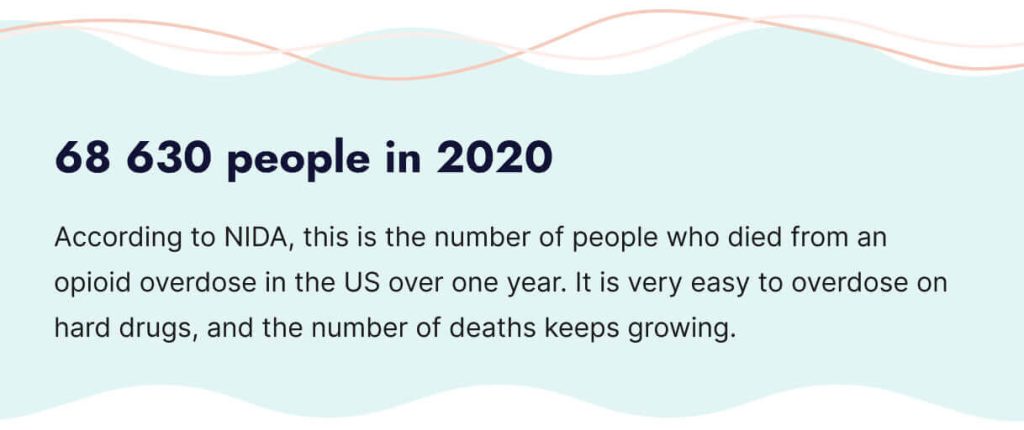
What Are the Signs?
Obviously, the first symptom of an addiction is the inability to stop taking the drug of choice and constantly needing more to get the same effect. However, we can look out for other red flags, too:
- The most common signs of stimulant use include restlessness, hyperactivity, weight loss, excessive aggression, impulsiveness, and frequent mood changes.
- When it comes to sedatives, impaired ability to move and speak, restlessness, excessive sweating, dizziness, and hallucinations are only a few of the possible symptoms.
- If a fellow student suffers from hallucinogen addiction, you may notice that they act strangely or have frequent and extreme mood swings: bouts of paranoia and depression alternating with the feeling of euphoria. They may have trouble sleeping and eating, sweat excessively, and lose coordination.
- When a person with a cannabis use disorder abstains from the drug, they may experience tremors, sweating, irritability, depression, and anxiety.
- If a person is addicted to meth or cocaine, you may notice that their pupils are dilated, they behave erratically, seem paranoid, lose their appetite, and experience sleep disorders.
- People with opioid addiction also experience problems with sleep and weight, uncontrollable movements, and cold flashes. They may also have trouble concentrating and be constantly exhausted.
Technology Addiction
Now, let’s shift gears and look at some less life-threatening addictions. But, even though they’re not as destructive, they still count as addictions since they cause the release of dopamine and are difficult to quit. Let’s see what they are.
What Are the Types?
Why Is It Dangerous?
It’s easy to think that addiction must be fairly harmless if substance abuse is not involved. This mindset is wrong and may lead to the situation getting out of control. It is especially hazardous if the addicted person refuses to see the problem and do something about it. So, what is at risk?
- Relationships. It’s frustrating to see your loved one so immersed in their phone or computer that they barely have time for you. They may be aggressive if you try to distract their attention from the device.
- Career and education. Sometimes technology addiction replaces all other interests. This is when a person will start neglecting their responsibilities. Loss of interest in studying is also one of the most noticeable effects of online gaming addiction in college students.
- Mental health. People with technology addictions often suffer from anxiety, depression, irritability, and restlessness. Those addicted to social media may develop body dysmorphia.
- Overall health. Poor sleep, weight gain or loss, headaches, and backaches also accompany such addictions.
What Are the Signs?
Here are the major red flags that can reveal to you that someone is suffering from technology addiction:
- Constantly thinking about using electronic devices.
- Not wanting to engage in real-life social interaction.
- Neglecting work, studies, and basic human needs in favor of spending more time gaming, gambling, or scrolling.
- Experiencing anxiety, depression, and other negative feelings.
- Compulsive use of technology, that is, grabbing the phone or turning on the computer needlessly.
- Using technology in inappropriate situations: for example, while driving or crossing the road, which may lead to fatalities.
Food Addiction
Students across the world know how hard it can be to eat healthily after moving out on your own. It’s only natural that many of them turn to fast food as a relatively cheap and quick way to reduce hunger.
But just like everything else, this simplicity and effectiveness come at a price. Eating disorders are very tough to manage and can cause just as much suffering as other types of addiction.
What Are the Types?
Why Is It Dangerous?
- Obesity. Being overweight increases one’s chances of cardiovascular diseases, diabetes, and digestive problems. However, it is crucial to remember that a person may actually be underweight while still suffering from food addiction.
- Tooth decay. In the case of bulimia, the teeth suffer alongside the gastrointestinal tract from the acid that accompanies the purging.
- Depression. People who suffer from binge eating and bulimia are often very unhappy with their lack of self-control and the way they look.
What Are the Signs?
- Obsession with food.
- Constant snacking in between meals.
- Middle-of-the-night snacking.
- Eating when no longer physically hungry.
- Feeling guilty after eating, which usually causes another binging session.
- Multiple attempts at dieting that end in failure.
Caffeine Dependence
When we speak about caffeine, we can’t really call it an addiction. While it triggers dopamine release, the amount is not enough to make caffeine dependence an addiction. However, it is a stimulant, and we can become attached to it very quickly.
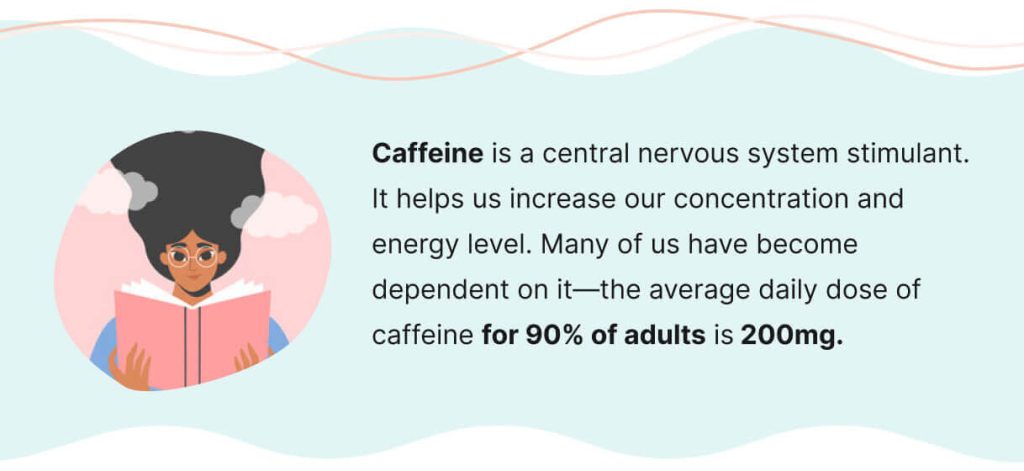
Caffeine addiction in college students is not surprising since they have so much to do and so little time to sleep. While coffee is relatively harmless and can even be beneficial, it can still cause trouble if consumed in excessive amounts.
What Are the Dangers?
- It doesn’t take a long time to develop tolerance. Coffee lovers consuming high doses of caffeine for a long time often complain that the drink loses its energizing effect.
- It can make you feel jittery. If you consume more than 400mg of caffeine, you might experience mild yet unpleasant shaking in your body. If it happens, you may want to take your coffee caffeine-free and supplement calcium and magnesium.
- Withdrawal symptoms. They are manageable and not life-threatening. If you decide to quit, you may experience headaches, fatigue, irritability, and concentration problems. However, if you push through it and adjust your diet accordingly, you may find that abstaining from caffeine can be beneficial and pleasant.
What Are The Signs?
Unfortunately, caffeine addiction and student life go well together. Let’s see how you can understand whether or not you have a healthy relationship with caffeine. Here’s what you have to pay attention to:
- Unsuccessful attempts at quitting.
- Withdrawal symptoms.
- Necessity to consume more and more over time.
- Planning your day around coffee breaks.
✨ How to Avoid Addictions in College: 12 Effective Tips
Now that we’ve taken a very close look at all the addictions that may be awaiting you in college, it is time to learn how to avoid them. Below you’ll find the essential tips that will help you ensure a wholesome and drug-free college experience:
- Avoid peer pressure. Easier said than done, huh? Nevertheless, it is crucial to put your health first in all situations. Remember that your friends may offer you a way to have fun, but you will be the one living with the consequences.
- Know your risk factors. You know yourself better than anyone. Try to keep in mind all your weaknesses and stay away from dangerous temptations.
- Seek help for mental disorders.. If you have a mental illness, try not to wait until you resort to unhealthy coping mechanisms. Remember that it’s crucial to take care of yourself and not to be afraid to seek help.
- Balance your schedule and get involved. It’s easy to lose yourself in the hectic schedule of college life. That’s why we urge you to make sure you know how to balance studying and entertainment. You are less likely to develop addictions when you always have something fun to do.
- Educate yourself. Knowing the consequences of substance abuse will make it easier to say “no.” If someone offers you a drug, wait until you’ve done your research and learned about its potential dangers.
- Talk about your struggles openly. If college life is getting too much for you, and you feel you may fall into temptation, don’t feel embarrassed about discussing your problems and asking for help.
- Monitor the intake of substances you choose to consume. If you decide to take a drug, be extremely careful, take all necessary precautions, and follow common sense.
- Find healthy ways to alleviate social anxiety. We know it’s hard, but there’s always a way to socialize successfully without additional substances.
- Say outright that you don’t drink or use drugs. If you’re firmly against addictive substances, tell people that you’re not interested in whatever they offer and that you’re confident about your decision.
- Avoid “party schools.” If you know you’re prone to having a little too much fun, begin your college application process by checking that the schools of your choice are not known as “party schools.” They’re full of triggers and temptations that will be hard to avoid if you end up there.
- Choose friends wisely. Surround yourself with people who, instead of dragging you down, will lift you up and inspire you to be the best version of yourself.
- List your personal reasons not to use drugs and stick to them. This list will be the foundation on which your determination to avoid addictions will stand.
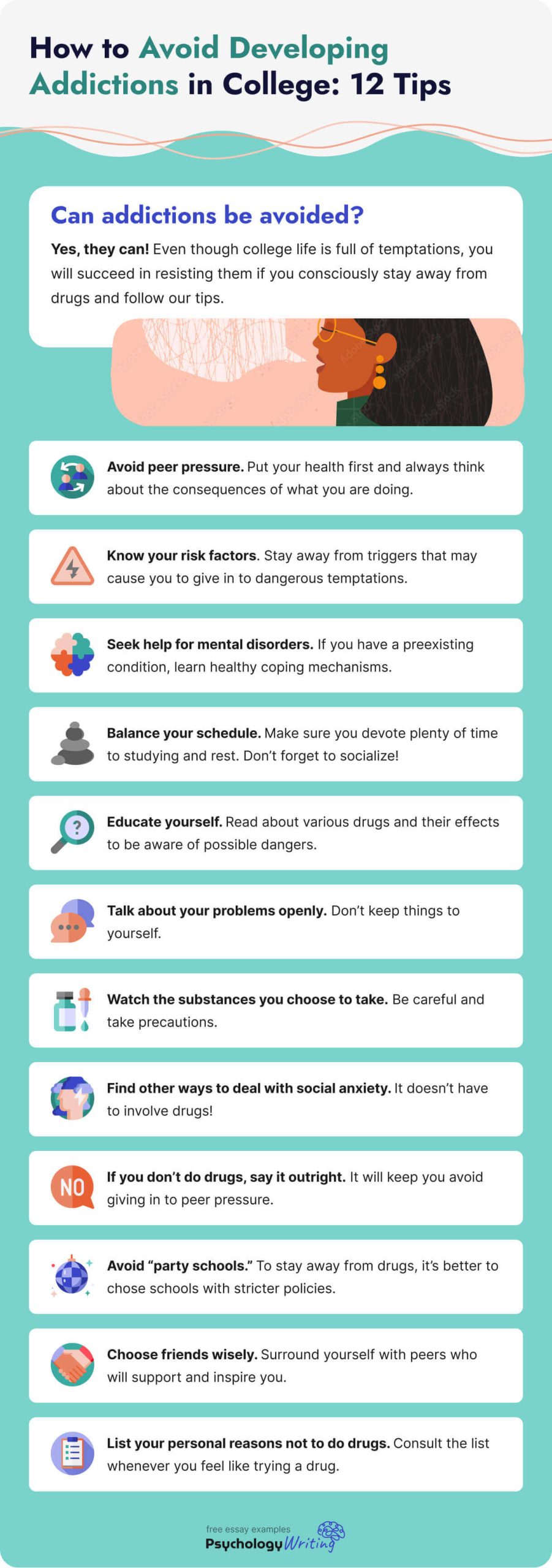
🏥 Where to Seek Help
But what can you do if, despite all precautions, you’ve found yourself on the verge of developing an addiction?
We understand that seeking help can be extremely difficult. You may be in denial, but once you realize that you have a problem, a feeling of shame often settles in. If that’s the case, and you’re unable to make yourself reach out to a rehab center, you can opt for low threshold intervention:
- turning to family and friends,
- on-campus facilities,
- therapy (especially CBT,)
- online help services,
- peer support.
These options are less stressful, and the necessary actions can be conducted in the comfort of your home or a therapist’s office.
There are also high threshold intervention options for people who need more serious help and rehabilitation. Various organizations in the US have student addiction treatment as their primary focus. Here are some of the best websites to check out:
- SAMHSA, or Substance Abuse and Mental Health Services Administration, allow you to find a treatment facility near you.
- National Institute on Drug Abuse will provide you with tons of helpful information on your problem.
- CoHEASAP offers resources to fight off addictions in a more informed manner.
- Smart Recovery helps you transition from an addict’s mindset to a more positive outlook with the help of support groups.
- The Hazelden Betty Ford Foundation provides multiple treatment locations and online help.
- Partnership to End Addiction can educate you on the prevention and treatment of addiction. You can even get involved in some of their activities yourself.
How to Know It’s Time to Stop
When it comes to addictions, people don’t always see the problem when they’re inside the situation. A student may be taking a drug recreationally or as a way to improve their academic performance. But if there is a possibility of becoming dependent on it, it’s good to know when to stop:
We recommend you to pay attention to these red flags, especially if you choose to take any addictive substance.
In conclusion, we want to assure you that college can be a fun experience without drugs and alcohol. It’s up to you to make it exciting, rewarding, and entertaining. But if problems arise, remember that it’s okay to ask for help. There are people who love you and will want to help you no matter what.
We’re looking forward to reading your thoughts on this topic in the comment section below!
🔍 References
- College Drug Abuse: Rehab Spot
- Consequences of Youth Substance Abuse: Office of Juvenile Justice and Delinquency Prevention
- The 6 Most Common Types of Technology Addiction: Family Addiction Specialist
- How to Tell if You Have Food Addiction: The Recovery Village
- Substance Abuse Organizations & Support: Orlando Recovery Center
- Substance Misuse in College Students: Psychiatric Times
- Signs and Symptoms of Alcohol and Drug Misuse or Abuse: Guilford College
- What to Know about Food Addiction: Medical News Today
- Fighting Food Addiction: American Psychological Association
- Are You Addicted to Technology?: Rutgers University
- Substance Use: Caffeine: My Health Alberta
- 5 Tips to Help Prevent Addiction Before It Starts: Agape Treatment Center
- Overcoming Drug Addiction: Help Guide

